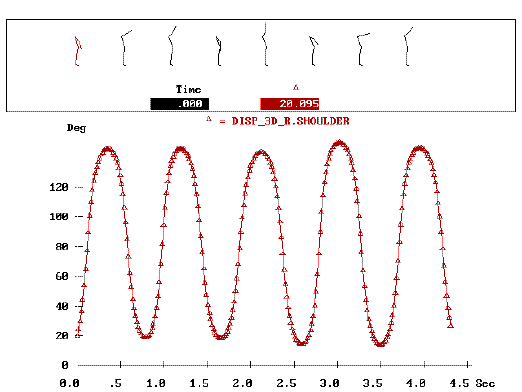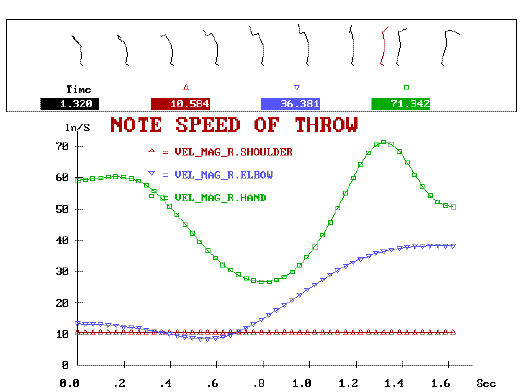Functional capacity - rotator cuff pathology
The patient is a 47 year old male, with a work
related shoulder injury. He was diagnosed as "rotator cuff tear". Surgical
repair was performed. Nine months later, he continued to complain of shoulder discomfort
and inability to perform his job functions. His physician ordered another surgical
consultation. As a prerequisite to the surgical consult, his employer ordered a functional
motion analysis, to determine if functional deficits are real or perceived.
Test Protocol
A test was designed to analyze the kinematics and kinetics
of functional work and leisure activities that the patient claims he was unable to
perform, due to range of motion limitations and pain. These activities were 1. Throwing
motion, 2. Hammering motion, 3. Overhead shoulder activities. Video computerized motion
analysis procedures were implemented to gather the necessary data.

Functional Shoulder Motion Analysis
Results Illustration I
Shoulder Kinematics
Active Range of Motion
Kinematic analysis [see Illustration I] revealed the
patient was capable of smooth, repeatable shoulder flexion/extension motions, with
no
evidence of pain related deflections. [see Graph I]

Graph I
Right Shoulder Flexion / Extension

Illustration II
Throwing Kinematics
Functional Throwing Results
Kinematic analysis [see illustration II] revealed the
patient was capable of a smooth throwing motion. [see Graph II]. The velocity measurements
of the right upper extremity, indicated the patient achieved throwing speeds that are
incompatible with a painful shoulder or rotator cuff tear.

Graph II
Linear Velocities - Right Arm
Functional Hammering Analysis
Kinematic analysis [see illustration III] revealed the
patient was capable of repeatable hammer swings, without pain related deflection. It was
noted that the patient hammered with his arm only, negating the effect of the trunk,
during the hammering action. The shoulder was performing as a brake for the action,
instead of acting as a conductor of muscle power from the body.

Illustration III
Hammering Kinematics
Outcome
The test results indicated the patient was not experiencing
functional deficiencies, as a result of shoulder pathology. Analysis of functional
technique revealed that he utilized his arm only, to accomplish his tasks. This technique
was putting extreme pressure on the shoulder. The patient was taught proper body mechanics
for his work related activities. The patient is currently back to work without complaint.